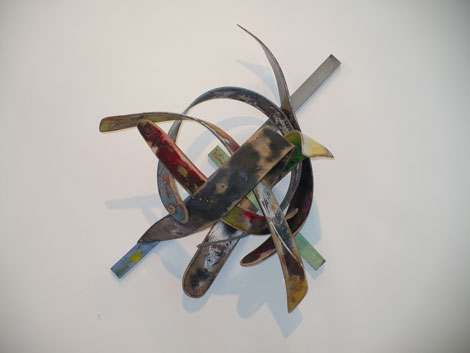“Speaking Tongues (The material of communication)” introduces Duane Paul’s considerable talent and ability in the artist’s first solo exhibition. The show’s 12 works (all 2013) are divided into three sections or “dialect clusters:” six works on paper, two free-standing sculptures and four wall reliefs. The dynamic exchange of visual dialogue among and between clusters is both provocative and revealing, centering on issues of texture, shape, size, color, line and volume.
Perhaps the works on paper could have been larger so that one might better appreciate their dense and richly worked surface textures. Their success is owed in part to 2-ply construction, revealing pockets of translucency that act as metaphors for unresolved fragments of childhood memories, juxtaposed with adult reflections, lessons and experiences. Paul introduces amoeba-like forms to these compositions, as visual anchors, focal points and enigmatic presences. The issues are of both a formal and personal nature.
Repetition signifies process, rhythm and progress. In Paul’s hands repetition and rhythm also become the tools for gathering a network of unresolved personal themes and challenges, offered up for resolution and/or transformation as revealed in the artist’s statement.
By repeatedly building up his sculpture’s surfaces, he employs a culture of “making and doing,” where the construction of the piece is as important as the final work itself. The repetitive process yields a form that physically resembles a thin, narrow seedpod, a rattle or elongated tongue. Their curvature is configured into a modified boomerang, and their layered construction mode is designed to expose layers of material information—levels of consciousness (similar to Mark Bradford’s “layered cutaways”), which eventually become visually unfamiliar and obscure. This is particularly so in Paul’s totemic piece; one example is a broken saddle in Humpty Dumpty’s Saddle Broke, which coincidently resembles an African headrest.
The mixed media wall reliefs exhibit Paul’s greatest strength as a painter and sculptor. Quite Rebellious, Stares Intently and Daddy Blows Smoke are two examples. Each piece offers a woven structure that allows for open-ended readings, of either coming into being as constructed (woven) or deconstructed (unwoven). Together the works balance motion and stillness in the most eloquent terms. They share the rhythmic turns and leaps found in Al Loving’s later works incorporating french curves and spirals. The reliefs’ impeccable workmanship recall the structured weavings of Martin Puryear’s craftsmen minimalist sculptures, with more painterly surface treatments, offering forms that are intentionally left ambiguous to the eye. As one observer noted, their polychromed surfaces echo the palette of Sam Gilliam’s early draped paintings. Tom Holland’s fiberglass 3-D paintings with physical strips attached to the painting’s surface also come to mind as a reference for Paul’s work. The tension created by the curvature in slats (made from a combination of various laminated materials, following the artist’s personal formulas) rivals the level of tension/drama found in Loren Madsen’s early “bend” pieces, created and fashioned from redwood slat and/or board back in the ’70s.
Paul’s exhibit is the result of the artist’s thinking-out-loud, in a much broader historical context that goes beyond generations, creating the profound conversation between the works engaged in “Speaking Tongues.”



















great love it.